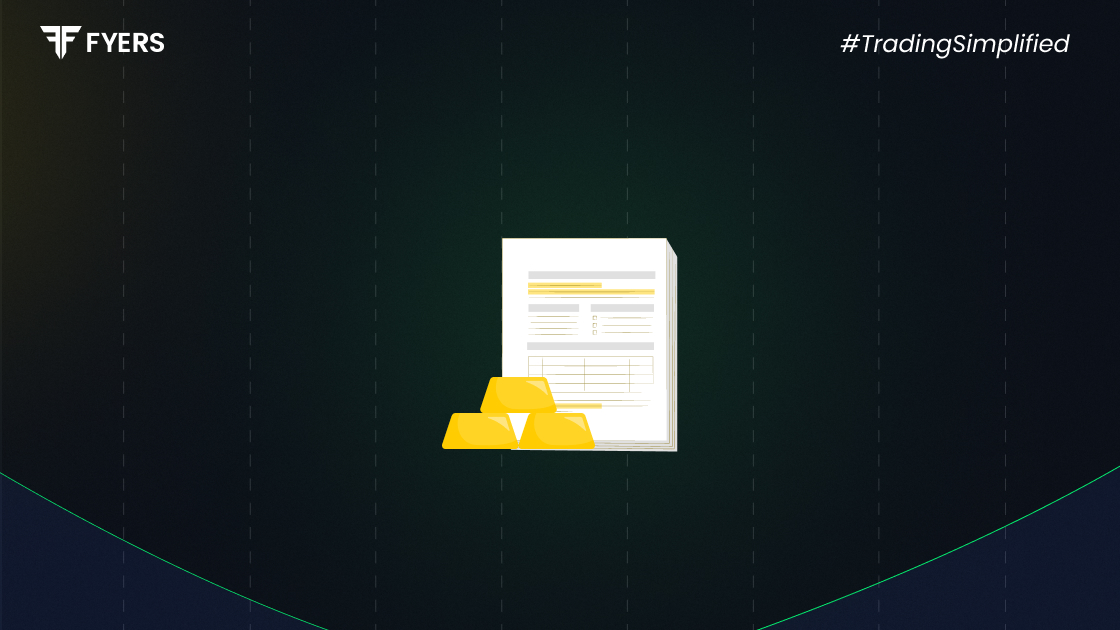

 26 Mar, 2025
26 Mar, 2025
 4 mins read
4 mins read

Gold has long been a cherished asset in India, symbolising wealth and security. In 2024, India's gold consumption rose by 5% to 802.8 tonnes, even amidst a 27% surge in prices. This uptick highlights the enduring allure of gold as an investment. However, with the challenges of storing and securing physical gold, many investors are turning to a more convenient alternative - paper gold. This modern investment avenue allows individuals to gain exposure to gold without the complexities associated with physical ownership.
Paper gold meaning - financial instruments that represent gold ownership without the investor physically holding the metal. These instruments track the price of gold, providing investors with a way to benefit from gold price movements without the logistical challenges of storing physical gold. Paper gold simplifies gold investment by making it digital and hassle-free.
Investors can choose from several forms of paper gold, each catering to different preferences and investment strategies:
Gold Exchange-Traded Funds (ETFs): These are like mutual fund schemes that invest in gold and are traded on stock exchanges, mirroring the price of physical gold. Investors can buy and sell units just like stocks, offering liquidity and ease of transaction.
Sovereign Gold Bonds (SGBs): Issued by the Government of India, SGBs are bonds denominated in grams of gold. They not only provide exposure to gold prices but also offer periodic interest payments to the tune of 2.5%, making them a dual-benefit investment.
Gold Futures and Options: These are derivative contracts that allow investors to speculate on the future price of gold. While they can offer significant returns, they also come with higher risk and are typically suited for experienced investors.
Gold Mutual Funds: These funds invest in gold ETFs and related assets, providing an indirect way to gain exposure to gold.
Digital Gold: Offered by various digital platforms and brokerage firms, allowing small investments in gold stored securely by a custodian.
Choosing paper gold over physical gold comes with several advantages:
Convenience: Eliminates the need for physical storage and security concerns associated with holding tangible gold.
Liquidity: Instruments like Gold ETFs can be easily bought and sold on stock exchanges during trading hours, providing flexibility to investors.
Cost-Effectiveness: Investing in paper gold often incurs lower costs compared to purchasing physical gold, which may involve making charges and storage expenses.
Additional Income: SGBs offer periodic interest payments, providing an extra income stream alongside potential capital appreciation.
Allows Tax Benefits: While investment in physical gold is subject to various taxes like GST or Wealth Tax, no such taxes are imposed on holding paper gold.
When deciding between paper gold and physical gold, it's essential to consider various factors:
|
Aspect |
Paper Gold |
Physical Gold |
|---|---|---|
|
Storage and Security |
No physical storage required; managed electronically. |
Requires secure storage and insurance to protect against theft or loss. |
|
Liquidity |
High liquidity; easily tradable on stock exchanges. |
Liquidity varies; selling may involve finding buyers and verifying authenticity. |
|
Costs |
Lower costs; minimal management fees. |
Higher costs; includes making charges, GST and storage expenses. |
|
Investment Size |
Flexible; can invest in small denominations. |
Typically requires a more substantial initial investment. |
|
Additional Benefits |
SGBs offer interest payments; ETFs provide market-linked returns. |
Potential for aesthetic and sentimental value; no interest income. |
Wondering how to purchase paper gold? Investing in paper gold in India is straightforward:
Gold ETFs: Open a demat and trading account with a registered stockbroker. Search for available Gold ETFs on the stock exchange and place buy orders through your trading platform.
Sovereign Gold Bonds: SGBs are available during specific issuance periods announced by the Government of India. Investors can apply through banks, post offices, or online platforms during these windows.
Gold Futures and Options: Engage with a broker who offers commodity trading services. Due to the complexity and risk involved, ensure you have a solid understanding of derivatives before investing.
In conclusion, paper gold presents a modern, efficient, and flexible approach to investing in gold, aligning with the evolving preferences of today's investors. By understanding the various forms of paper gold and their respective benefits, individuals can make informed decisions that complement their financial objectives.
Paper gold can be a prudent addition to a diversified investment portfolio, offering exposure to gold price movements without the challenges of physical ownership. However, as with all investments, it's essential to assess your financial goals, risk tolerance, and investment horizon before committing.
Taxation on paper gold varies based on the instrument and holding period:
Paper gold investments, particularly those backed by reputable institutions like the Government of India (in the case of SGBs) or established financial entities (for ETFs), are generally considered safe. They offer a secure and regulated way to gain exposure to gold prices.
Calculate your Net P&L after deducting all the charges like Tax, Brokerage, etc.
Find your required margin.
Calculate the average price you paid for a stock and determine your total cost.
Estimate your investment growth. Calculate potential returns on one-time investments.
Forecast your investment returns. Understand potential growth with regular contributions.